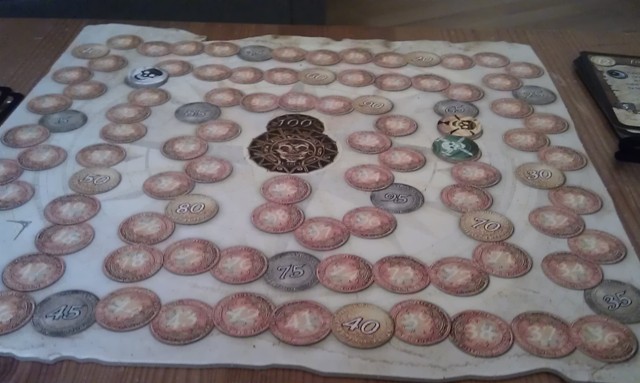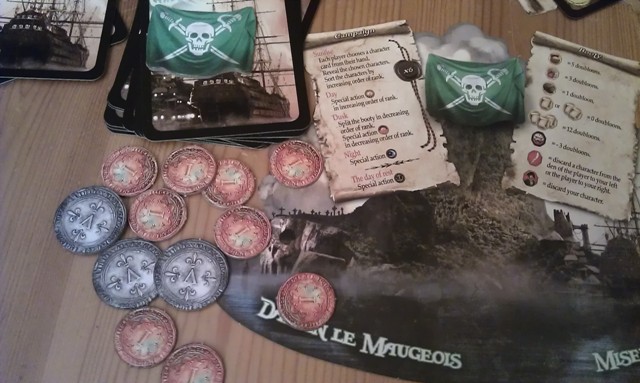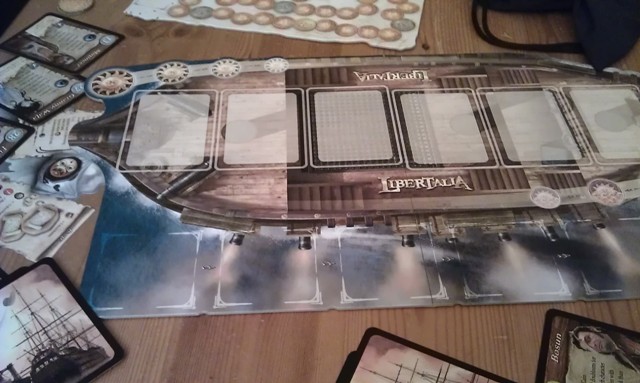Libertalia Review
Wanna be a pirate? Damn right you do.
Libertalia’s glorious box art goes a long way towards setting the thematic scene for the game: a collection of some of the most piratey pirates imaginable, centred around a shrewd-looking Barbossa-alike appraising a shiny piece of treasure (damn, Geoffrey Rush is awesome).
The game takes its name from that of a utopian pirate colony it is the player’s responsibility to create, each taking on the mantle of one of six pirates nearing the end of their pirate careers in order to do so (so, if you think about it, Libertalia is essentially about creating an old seadog’s retirement home). As you might expect of any game involving pirates, the aim is to be the one with the most booty at the end.

As mentioned before, the game’s art, which is by Ben Carré and Stéphane Gantiez, is really impressive, although the fact that its motifs bear more than a passing resemblance to those of the Pirates of the Caribbean series meant that we were obligated to listen to the soundtrack while we played (not that this is a bad thing). The game board, styled to look like a pirate ship right down to its actual shape, is accompanied by six pirate den cards, a score track board and tokens, crew marker cards, character cards and, of course, a generous number of booty tokens and dubloons. We also spent a disproportionate amount of time gushing over the box as we were packing up after playing: with enough compartments to comfortably accommodate all the various cards and tokens as well as the handy drawstring booty bag to prevent some of them from freely roaming, this is one game you won’t open a few weeks later to find your carefully ordered contents in disarray.
Libertalia is a fairly simple game once you’re use to the order of things (which the instruction booklet – or logbook – quickly and clearly explains), but this certainly doesn’t detract from the fun. The game is played over three rounds, known as campaigns, each comprised of four phases: sunrise, day, dusk and night. The character cards are the centre of the game, each having a rank, influence rating and special action (or actions), each of which must be used in the phase indicated on the card. Some characters have actions that can only be used at the end of a campaign which, if you play your cards right (sorry), can result in some really powerful plays.

To give you a better illustration, here’s how a typical campaign works:
1) Sunrise – During the sunrise phase, each player secretly picks a character card and places it face down. The cards are then revealed and placed on the ship-shaped board in rank order.
2) Day – In this phase, the special day actions of the character cards that have been played will be resolved in increasing order of rank.
3) Dusk – Booty time! In decreasing order of rank, each player chooses a booty token from the selection in the space under the ship corresponding to the day played. Booty tokens can be cursed (which cost you dubloons), Spanish officers (which cause your character to be discarded) or sabres (which allow you to tactically assassinate your rivals’ characters and send them to the graveyard)
4) Night – All characters located in players’ dens (where they usually end up after being played) resolve any night actions they have simultaneously
5) The Day of Rest – This phase, also known as the scoring phase, only happens at the end of the campaign. All denned characters’ end of campaign actions are simultaneously resolved and booty is counted up and score tokens’ positions on the score track board adjusted accordingly.
In preparation for the next campaign, characters in the den and graveyard are permanently discarded (those in the graveyard can be retrieved prior to this as a result of certain cards’ abilities), all booty tokens and dubloons are returned and the starting amount of the latter redistributed and new character cards drawn. Your final score is the sum of all the dubloons you won during the game’s three campaigns, and there’s definitely a sense of triumph to be had in seeing your score token nearest the glittering trinket at the centre of the track. However, this does look awfully like one of the cursed coins from Pirates, so perhaps that’s not the best place to be if you think about it…
On the other hand, BOOTY.

VERDICT: Libertalia is easy to play and great fun. Although the sheer simplicity of its rules can lead to the odd moment of confusion (for example at one point we spent five minutes trying to work out how a particular situation should be dealt with in accordance with the rules as it wasn’t explicitly stated anywhere), there’s generally little to impede your grog-flavoured boardgaming experience. With beautiful art, attractive pieces and a quality box, it’s definitely a well-made product.
Furthermore, its easy suitability for anything from two to six players makes it a good one to have in the cupboard (although it definitely seems like a game where the mantra “the more, the merrier” is a good one to bear in mind). In short, if you like pirates and/or you like boardgames, you can’t go far wrong with Libertalia; just make sure you think carefully before taking the governor’s daughter out for a spin.




